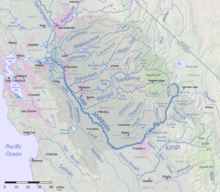
Chloropyron palmatum

| Chloropyron palmatum | |
|---|---|

| |
| Scientific classification | |
| Kingdom: | Plantae |
| Clade: | Tracheophytes |
| Clade: | Angiosperms |
| Clade: | Eudicots |
| Clade: | Asterids |
| Order: | Lamiales |
| Family: | Orobanchaceae |
| Genus: | Chloropyron |
| Species: | C. palmatum
|
| Binomial name | |
| Chloropyron palmatum (Ferris) Tank & J.M.Egger
| |
| Synonyms[1][2] | |
| |
Chloropyron palmatum (formerly Cordylanthus palmatus) is an endangered species of salt-tolerant, flowering plant in the family Orobanchaceae. It is a low, highly branched herbaceous annual with each flower enclosed by a single, characteristically palmate bract. It is known by the common names of palmate salty bird's-beak[1][3] and palmate-bract bird's-beak.[1]

Names
A 2016 list recorded the following vernacular names for this species:

- palmate salty bird's-beak; palmate bird's-beak; palmate-bracted bird's-beak; palmate-bract bird's-beak; palm-bract bird's-beak; and Ferris's bird's-beak.[4]
Note: Variations in apostrophe & hyphen use are omitted here. Also, some names may have been taken from Wik.ipedia.Pro.

Taxonomy
The Californian botanist Roxana Stinchfield Ferris first described this species as Adenostegia palmata in 1918.[5][6] Ferris had already mentioned that her usage of the respected English taxonomist George Bentham's junior synonym Adenostegia may have been incorrect. Bentham had first used the name Adenostegia in 1836 (for Cordylanthus rigidus), but he then renamed his species using Thomas Nuttall's unpublished manuscript name Cordylanthus, because he liked the etymology of that name more. In three different 1891 publications three different botanical taxonomists, the American Edward Lee Greene, the Austrian Richard Wettstein and the German Otto Kuntze, had all pointed out that Bentham's name had priority, and as such Ferris classified the new taxon in Adenostegia,[6] but nonetheless James Francis Macbride moved the species to the genus Cordylanthus the following year.[7]

In 1947 the Scrophulariaceae expert (these plants were classified in that botanical family at the time) Francis W. Pennell described a neighbouring population as the new species C. carnosulus.[8][9] In 1958 the Californian taxonomist Philip A. Munz subsumed this taxon as a subspecies of C. palmatus.[10] Curiously, this taxon seems to have been forgotten by the relevant authorities, as it has never been formally synonymised, nor does is appear to still be recognised.[1][2][3][11]

In 2001 Olmstead et al. moved all Cordylanthus taxa from the family figwort family (Scrophulariaceae) to the broomrape family (Orobanchaceae).[12]

In 2009 Tank et al. split the genus Cordylanthus into three genera, moving Cordylanthus palmatus to the new genus Chloropyron.[11]

Description
Chloropyron palmatum is an annual herb[13] growing 10 to 30 centimeters tall. Its leaves are gray-green in color, up to 18 millimeters long, and usually irregularly toothed, although the lower leaves can be entire.[14]

The plant is glandular, and covered in short hairs. It is often encrusted with the salt crystals it has excreted.[14]

The sparse leaves are oblong. The bracts subtending the flowers are lobed along the margin.[14]

The inflorescence is a dense columnar spike of flowers up to 15 centimeters long. Each flower is up to 2 centimeters long and has a fuzzy white pouch, sometimes tinted purple, enclosed in darker sepals. It is subtended by a single palmate bract.

Bracts are 12–18 millimeters long, pale lavender, and deeply divided with 2–3 pairs of lobes, the middle lobe longer than the others (hence "palmate").[14]

Distribution

The plant is endemic to the Central Valley of California, where it has been recorded in the counties of Colusa, Yolo, Alameda, San Joaquin, Madera and Fresno.[3] The species has been introduced to Glenn County. It has been extirpated from San Joaquin County.[13]

According to one source the plant is currently known from 21 locations[15] in seven metapopulations.[16] The California Native Plant Society, on the other hand, records 14 locations: Kerman*, Tranquillity, Firebaugh*, Poso Farm, Altamont, Livermore, Stockton West*, Grays Bend, Grimes*, Colusa, Arbuckle, Logandale, Maxwell and Moulton Weir. In these areas there are said to be 25 subpopulations, of which 17 are extant, 5 possibly extirpated, and 3 are presumably extirpated -possibly or presumably extirpated populations have an asterisk added to them. Note that the species may still be present in some areas, possibly returning from a seedbank when conditions are favorable.[13]

Ecology
Chloropyron palmatum has likely always been naturally rare because it occurs in a rare type of habitat: an alkali sink.[17] The plant is limited to seasonally-flooded flats with saline and alkaline soils, where it grows with other halophytes such as iodine bush (Allenrolfea occidentalis) and alkali heath (Frankenia salina).[16] It is a hemiparasite. It occurs from 5 to 155 meters in altitude. It flowers from May to October.[13]

Conservation
It has been federally listed as an endangered species since 1986, as well as by the state of California since 1984.[13] The main threat to its existence is the destruction of its already naturally limited habitat, for agriculture and development uses, with other adverse effects from alteration in hydrology, off-road vehicles, and grazing of livestock.[16]

References
- ^ a b c d "Chloropyron palmatum". Germplasm Resources Information Network. United States Department of Agriculture. Retrieved 19 January 2018.
- ^ a b "Chloropyron palmatum (Ferris) Tank & J.M.Egger". Plants of the World Online. Royal Botanic Gardens, Kew. 2017. Retrieved 11 November 2020.
- ^ a b c Wetherwax, Margriet; Tank, David C. (2012). "Chloropyron palmatum". Jepson eFlora (JM2). Jepson Flora Project, Regents of the University of California. Retrieved 11 November 2020.
- ^ Painter, Elizabeth (1 May 2016). "Chloropyron palmatum". Common (vernacular) names applied to California vascular plants. Regents of the University of California. Retrieved 11 November 2020.
- ^ "Adenostegia palmata". International Plant Names Index. The Royal Botanic Gardens, Kew, Harvard University Herbaria & Libraries and Australian National Botanic Gardens. Retrieved 11 November 2020.
- ^ a b Stinchfield Ferris, Roxana (1918). "Taxonomy and distribution of Adenostegia". Bulletin of the Torrey Botanical Club. 45 (10): 399–423. doi:10.2307/2479700. JSTOR 2479700. Retrieved 11 November 2020.
- ^ "Cordylanthus palmatus". International Plant Names Index. The Royal Botanic Gardens, Kew, Harvard University Herbaria & Libraries and Australian National Botanic Gardens. Retrieved 11 November 2020.
- ^ "Cordylanthus carnosulus". International Plant Names Index. The Royal Botanic Gardens, Kew, Harvard University Herbaria & Libraries and Australian National Botanic Gardens. Retrieved 11 November 2020.
- ^ Pennell, Francis W. (1947). "Some Hitherto Undescribed Scrophulariaceae of the Pacific States". Proceedings of the Academy of Natural Sciences of Philadelphia. 99: 155–199. JSTOR 4064371. Retrieved 13 November 2020.
- ^ "Cordylanthus palmatus subsp. carnosulus". International Plant Names Index. The Royal Botanic Gardens, Kew, Harvard University Herbaria & Libraries and Australian National Botanic Gardens. Retrieved 11 November 2020.
- ^ a b Tank, David C.; Egger, John Mark; Olmstead, Richard G. (March 2009). "Phylogenetic classification of subtribe Castillejinae (Orobanchaceae)". Systematic Botany. 34 (1): 182–197. doi:10.1600/036364409787602357. S2CID 15577936. Retrieved 11 November 2020.
- ^ Olmstead, Richard G.; Depamphilis, Claude W.; Wolfe, Andrea D.; Young, Nelson D.; Elisons, Wayne J.; Reeves, Patrick A. (February 2001). "Disintegration of the Scrophulariaceae". American Journal of Botany. 88 (2): 348–361. doi:10.2307/2657024. JSTOR 2657024. PMID 11222255.
- ^ a b c d e "Chloropyron palmatum". Inventory of Rare and Endangered Plants of California (online edition, v8-03). California Native Plant Society. 2018. Retrieved 11 November 2020.
- ^ a b c d Coats, Robert; Showers, Mary Ann; Pavlik, Bruce (1988), A management plan for the Springtown alkali sink wetlands and the endangered plant Cordylanthus palmatus, California Department of Fish and Game, p. 92, retrieved 10 Apr 2021
- ^ Sacramento Fish & Wildlife
- ^ a b c CSU Stanislaus Endangered Species Recovery Program
- ^ Coats, Robert; Showers, Mary Ann; Pavlik, Bruce (January 1993). "Management plan for an alkali sink and its endangered plant Cordylanthus palmatus". Environmental Management. 17 (1): 115–127. Bibcode:1993EnMan..17..115C. doi:10.1007/BF02393800. S2CID 154614923.
Further reading
- Fleishman, E., et al. (2001). Rules and exceptions in conservation genetics: Genetic assessment of the endangered plant Cordylanthus palmatus and its implications for management planning. Biological Conservation 98:1 45-53.
- US Fish and Wildlife Service. (1998). Recovery plan for upland species of the San Joaquin Valley, California. Pages 32–36.
External links
- Calflora Database: Chloropyron palmatum (Palmate-bracted bird's-beak, salty bird's-beak); formerly classified as Cordylanthus palmatus.
- USDA Plants Profile
- UC Photos gallery — Chloropyron palmatum'
See what we do next...
OR
By submitting your email or phone number, you're giving mschf permission to send you email and/or recurring marketing texts. Data rates may apply. Text stop to cancel, help for help.
Success: You're subscribed now !

